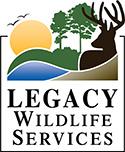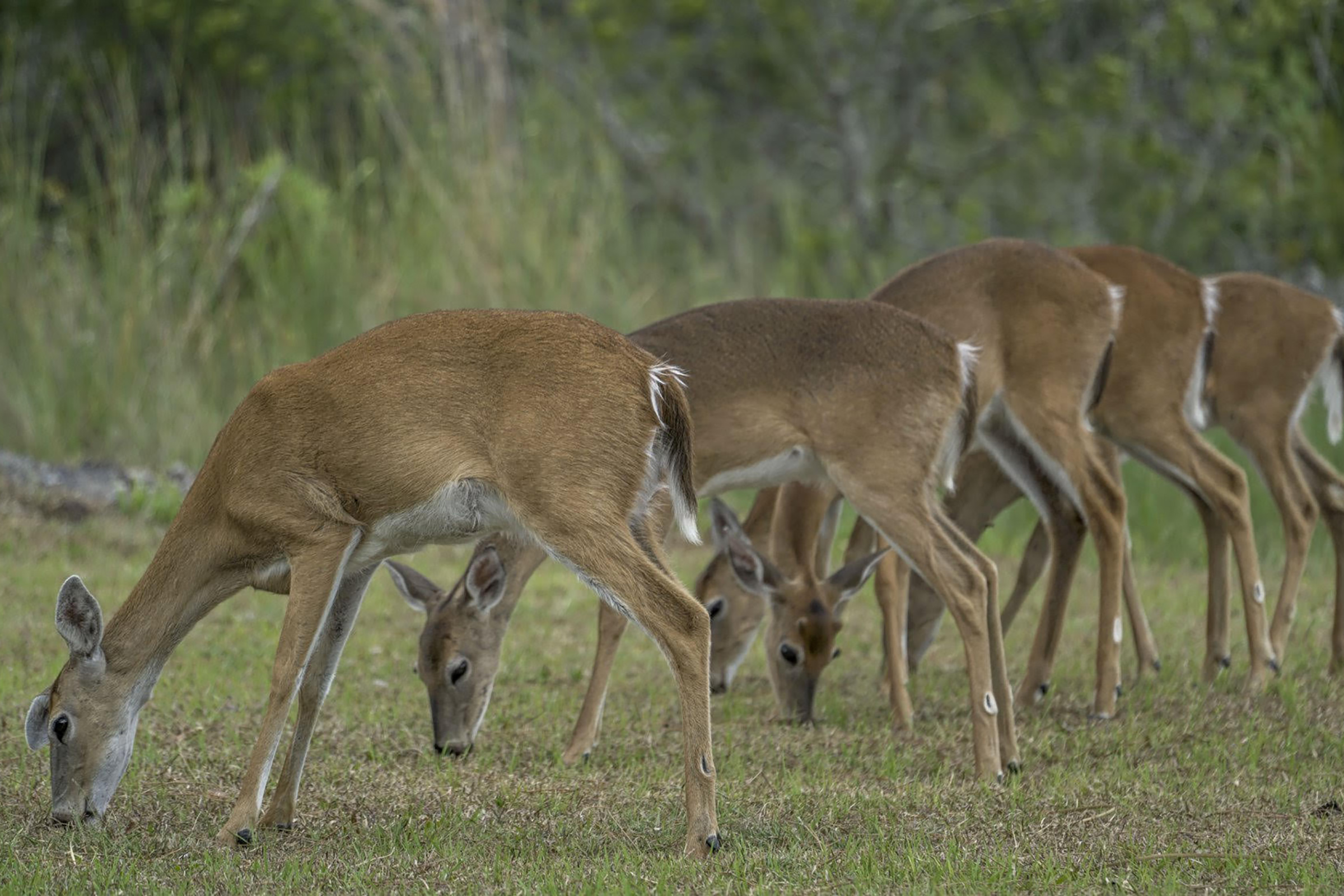
Chronic Wasting Disease (CWD) is quite a hot topic in the deer hunting world lately and should not be taken lightly. With numerous cases creeping outwards, the southern states are attempting to take as many preventative cautions as possible to keep this fatal disease out of our deer herds. CWD is an infectious, incurable disease of animals in the deer family that causes brain cells to die, ultimately leading to the death of the affected animal. If that isn’t scary enough, experts now urge hunters to avoid eating venison from a CWD-positive animal even though there are no documented cases of humans contracting CWD from eating wild game. While CWD is already found in 26 US states, what are the precautionary steps in place to prevent the spread of this devastating disease? What can you do as a hunter to prevent the spread of CWD?
PROGRESSION OF CWD-POSITIVE STATES AND PROVINCES

Source: National Deer Association
Hunters planning to hunt out of state need to be aware of the rule changes to most southern states regarding transporting your harvested animal. Florida and Alabama only allow deboned meat and finished taxidermy products for any deer species to return with you from any out-of-state hunt, while Georgia enforces the same law if you are returning from a CWD positive state. Hides, antlers, skulls, skull caps, and teeth can be transported if all soft tissue has been removed and has been cleaned. This is not an easy task for the average hunter, which is why it is recommended to leave your trophy with a taxidermist before bringing it back home.
Of the 26 states that have confirmed cases of CWD, 2 of those states fall in the deep south. That includes Arkansas and Mississippi. If you were to visit each of these 26 state’s Department of Wildlife websites, you would find there are similarities with how they are handling CWD cases. Each state will also have variations of regulations different from other states to suit the needs of that individual state.
Arkansas
According to the Arkansas Game and Fish Commission (AGFC) Arkansas has tested 33,233 deer and elk and have reported 1,112 positive cases, 1,081 WTD and 31 elk as of Fall 2021. These positive cases have been reported in 14 northwest Arkansas counties with the 1st reported cases in 2016.
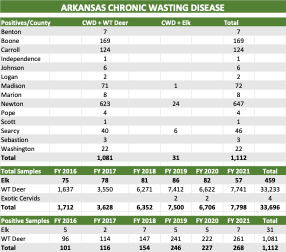
Source: Arkansas Game and Fish Commission
Arkansas is working to slow the spread of CWD and trying to keep it within the containment zone with the help of local hunters and state agency personnel. Regulations have been put into place to try and help reduce CWD movement throughout the state.
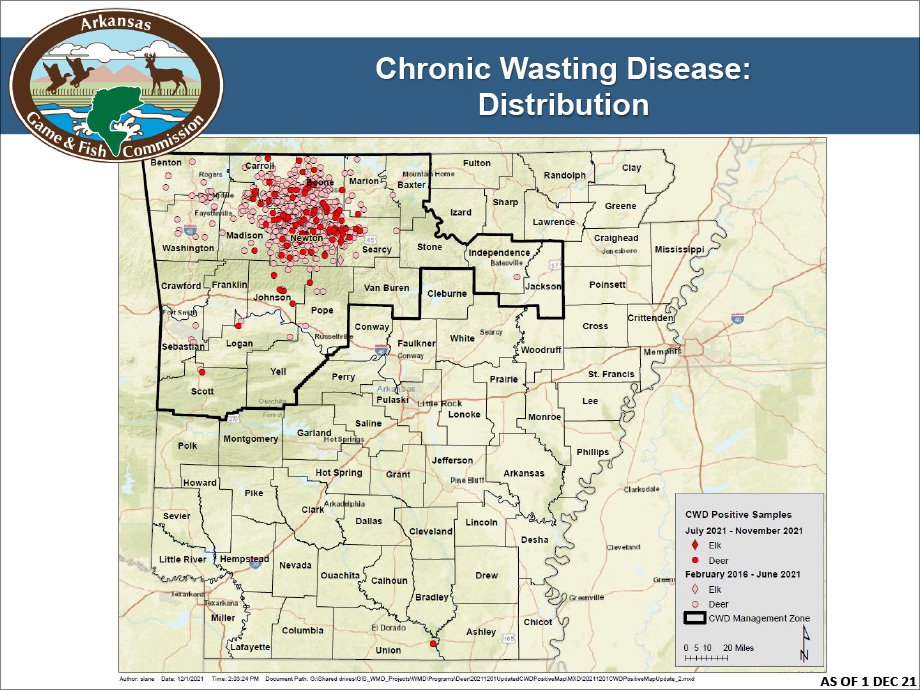
Source: Arkansas Game and Fish Commission
Regulation Changes
With CWD being present in Arkansas, restrictions needed to be put into place with regards to harvested WTD and elk carcass movement both within state lines and across state lines. Arkansas has deemed it illegal to possess, import, and/or transport, any portion of a deer, elk, moose or caribou harvested outside of the state within Arkansas, unless it is the following low-risk parts of the animal:
- Antlers and/or antlers attached to clean skull plates or cleaned skulls (where no meat or tissues are attached to the skull)
- Deboned meat.
- Teeth with no meat or tissue attached.
- Tanned hides.
- Completed taxidermy.
Any deer or other cervid species harvested between the Mississippi River levees in Tennessee and Mississippi are excluded from the above regulations.
Arkansas has deemed it illegal to possess and transport any deer or elk harvested within the CWD Management Zone to any location within the state outside the marked management zone unless it includes the low-risk items listed above. It is also deemed illegal to possess any deer or elk harvested within Tier 1 of the CWD Management Zone (red) in Tier 2 (orange), except the low-risk materials listed above.
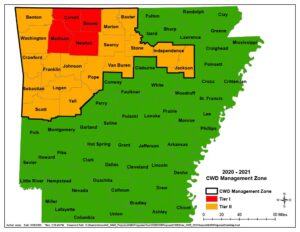
Source: Arkansas Game and Fish Commission
Please note that whole carcasses harvested in Tier 1 (red) counties may be moved freely between the Tier 1 counties. Only low-risk parts, listed above, may be moved into Tier 2 (orange) counties or outside the CWD Management Zone.
Complete carcasses harvested in Tier 2 (orange) counties may be moved freely between the Tier 2 counties or into Tier 1 counties. Only low-risk parts, listed above, may be moved outside the CWD Management Zone.
Baiting Regulations
According to the AGFC, it is deemed illegal to feed wildlife within the CWD Management Zone. There are exceptions to this. They are:
- Bait can be used to hunt deer and elk on private land from Sept. 1-Dec. 31.
- Food plots may be used year-round.
- Baiting bears on private land is allowed 30 days before bear season opens. However, before Sept. 1, bears may only be baited with dog food, cat food, pastries/bread, cooking oils/grease, non-wildlife meat scraps, popped popcorn, fish, and fish byproducts.
- Trapping furbearers with the use of bait during open furbearer trapping seasons or hunting furbearers during open furbearers hunting seasons on private land.
- Incidental feeding of wildlife from active livestock operations is allowed.
- Normal agricultural, gardening, or soil stabilization practices are allowed.
- Attracting or feeding birds and squirrels with common bird and squirrel feeders, birdbaths and grain completely submerged in water is allowed.
- Baiting is allowed for management, research, or nuisance wildlife control only with approval by the AGFC Chief of Wildlife Management.
CWD Testing
While submitting CWD samples for testing is voluntary, it is highly recommended, especially in or near areas where CWD is known to be present. To drop off samples to be tested, locate a sampling drop-off sight near you and follow the instructions for leaving the samples at the site. If you have questions regarding your CWD samples, please contact your local state wildlife biologist for further details. Below are instructions for collection of CWD samples and drop off.
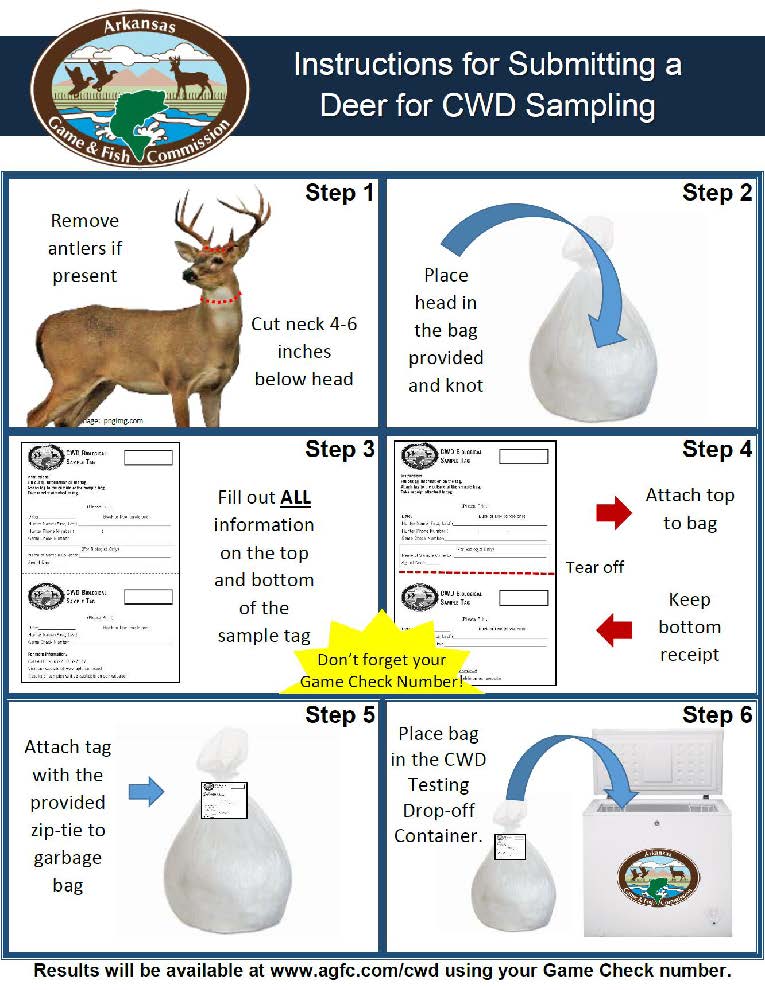
Source: Arkansas Game and Fish Commission
To see more specific CWD data and understand what deer and elk harvest and transport regulations are, you can visit the AGFC CWD page at https://www.agfc.com/en/hunting/big-game/deer/cwd/. There is also a link to a short video showing hunters how to prepare deer and elk carcasses for CWD sampling, https://youtu.be/lJNqdy0DIIg.
Mississippi
Arkansas’ neighbor to the east, Mississippi, has reported CWD cases as of recent years. According to the Mississippi Department of Wildlife Fisheries and Parks, (MDWFP), the 1st reported case was found in 2018 in Issaquena County, but the core of reported cases are in northern Mississippi near the Tennessee state line. Tennessee is another CWD-positive state. Since the initially reported case in 2018, 81 more positive cases have been confirmed in 7 northern Mississippi counties. Over 8,000 deer have been tested in Mississippi.
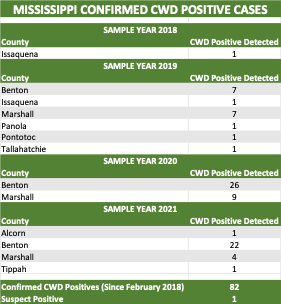
Source: Mississippi Department of Wildlife, Fisheries, and Parks
Mississippi has also been working diligently to keep CWD within the containment zones. The MDWFP has put out a lot of useful information on their website concerning the fatal disease including an annual CWD report, CWD Best Management Practices, (BMPs) manual, identification of the CWD management zones, and deer harvest regulations within these zones.
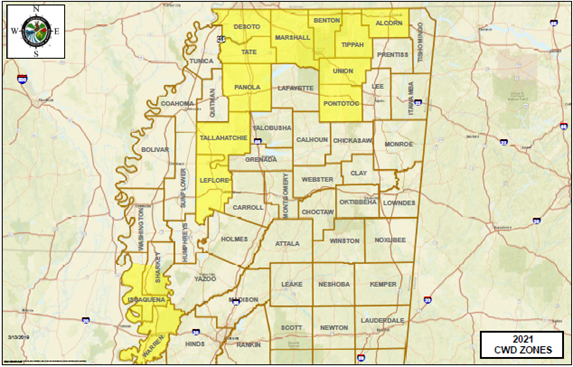
Source: Mississippi Department of Wildlife, Fisheries, and Parks
CWD Best Management Practices (BMPs)
According to the MDWFP CWD Manual, BMPs were put in place to reduce environmental and human exposure to CWD while handling carcasses and processing the meat. The following includes more detail concerning BMPs for CWD.
CWD BMPs include:
- Carcasses may not be transported outside of any CWD Management Zone. Research has shown that decomposed carcasses of infected animals can also contribute to the transmission when prions bind to soil and plant material. Thus, the movement of carcasses may introduce CWD into previously uninfected areas. Any harvested deer may be taken directly to a taxidermist or meat processor within the CWD Management Zone. Only the below products may leave the zone:
- Cut/wrapped meat (commercially or privately)
- Deboned meat
- Hides with no head attached
- Finished taxidermy
- Antlers with no tissue attached
- Cleaned skull plates (no brain tissue)
- Cleaned skulls (no lymphoid or brain tissue)
- Supplemental feeding is banned in all CWD Management Zones (salt licks, mineral licks, and feeders). Direct contact with prions is the most effective means of transmitting CWD. Research indicates saliva may have the highest concentration of prions. Thus, to minimize the concentration of deer and the potential spread of CWD, supplemental feeding is banned within all CWD Management Zones.
Other General Precautions
- Inspect the body condition of each deer at the time of harvest.
- Do not consume any part of animals exhibiting clinical symptoms of CWD.
- Please report any deer that appears to be diseased by completing a diseased deer report on the MDWFP app, at mdwfp.com/cwd or call 1-800-BE-SMART.
- Avoid using natural deer urine attractants. They may carry prions from infected deer.
- Hunters who prefer to use lures or attractants may wish to select an artificial or food-based scent.
- To minimize direct contact with infectious prions, it is recommended to not establish feeders, bait sites, mineral sites, or otherwise cause.
Field Dressing
- Wear rubber or latex gloves when handling carcasses.
- When field-dressing an animal, leave internal organs and inedible parts at the site of harvest.
- Avoid sawing through bone, spinal cord, brain, lymph nodes, or spleen.
- Store all portions of the animal to be transported in a container such as a cooler, bin, or bag that will not leak bodily fluids into the environment.
Meat Processing
- Do not process a deer that appears to be diseased.
- Process all deer individually, package separately, and label uniquely.
- Debone meat from deer and remove all fat, connective tissue, and lymph nodes.
- Avoid sawing through bone, spinal cord, brain, lymph nodes, or spleen.
- Avoid eating/handling the eyes, brain, spinal cord, spleen, and lymph nodes.
- Limit the amount of bodily fluids going to an area, such as a floor drain, that cannot be properly sanitized after use.
Disposal
- Deer parts should not be rendered for use in feed for other animals or used as compost.
- Recommended disposal methods for unwanted portions of carcasses (bones, organs, etc.) are:
- Leave at the harvest site;
- Double-bag and send to an approved, lined landfill; or
- Deep burial (8 feet or deeper).
Equipment Cleaning
- Clean processing equipment between each deer.
- Thoroughly sanitize all equipment and workstations with a 50:50 solution of bleach and water.
- Soak tools for one hour in the bleach solution, and then rinse thoroughly with hot water.
To view all CWD information and gain helpful knowledge about how the MDWFP is working to reduce the spread of CWD, and what you as a hunter can do to help, you can visit the MDWFP CWD page at https://www.mdwfp.com/wildlife-hunting/chronic-wasting-disease/. MDWFP also includes a short video showing hunters how to prepare deer carcasses for CWD sampling, the link is https://www.mdwfp.com/wildlife-hunting/chronic-wasting-disease/sample-collection/.
Louisiana
While Louisiana has not reported a case of CWD, it is surrounded by 3 states that are CWD positive, Arkansas, Texas, and Mississippi. But that doesn’t mean Louisiana is taking this lightly. Being enclosed per say, by 3 positive states means more due diligence has to be put forth to reduce the chance of CWD entering the state.
What is the Louisiana Department of Wildlife and Fisheries (LDWF) doing to monitor the state’s whitetail deer herd for the presence of CWD? Up to this point the LDWF has collected over 2,000 CWD samples and continues to collect these samples and test them moving forward.
The LDWF also is working to monitor whitetail deer carcass importation into the state by regulating what parts of the deer can be brought across state lines. Some of this includes deboned meat that is wrapped, antlers on cleaned skull plates, tanned hides, cleaned skulls, and completed mounts.
If CWD is ever reported in Louisiana, like Arkansas and Mississippi, the LDWF will apply CWD management zones and implement restrictions and regulations to reduce the chance of the spread outside of the containment zone and begin monitoring the disease.
To read more about how the LDWF will continue to monitor CWD and their plans if a deer tests positive, and what you as a hunter can do to help, you can visit the LDWF CWD page at https://www.wlf.louisiana.gov/page/cwd. The LDWF also includes a short video showing hunters how to cape your deer carcasses for transport across Louisiana state lines, the link is https://youtu.be/HEgF4HBWkTw.
Final Words
If at any time you suspect a deer to be sick, whether viewed during hunting season or even outside of hunting season, or harvested during the hunting season, you should contact your state and local wildlife agency biologist about how to handle and process these animals. They will relay to you full instructions on how to take samples for testing and how to handle the animal for processing.
It is always recommended to be proactive when it involves wildlife-related issues such as CWD. Attending local wildlife meetings, seminars, extravaganzas, or talking to your local wildlife biologist can help you gain much knowledge regarding CWD. The more you know, the more you will understand how CWD can impact your deer herd and you will be better equipped to help slow the spread of CWD.
If you have any specific CWD-related questions you can contact one of the Legacy Wildlife Services wildlife biologists.
Will McCrea is the wildlife biologist for our Florida, Georgia, and Alabama properties and can be reached at 352-231-9715 or by email at [email protected].
David Graves is the wildlife biologist for our Mississippi, Arkansas, and Louisiana properties and can be reached at 318-464-2744 or by email at [email protected].
